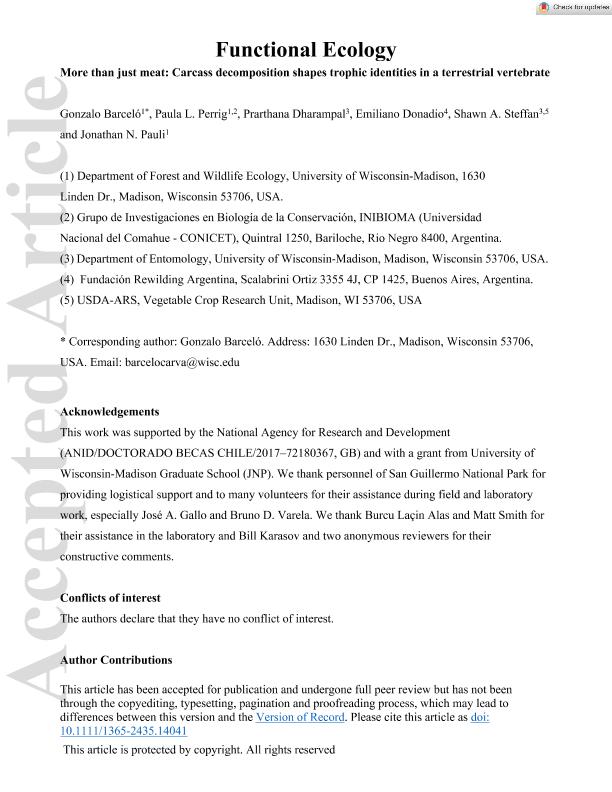Mostrar el registro sencillo del ítem
dc.contributor.author
Barceló, Gonzalo
dc.contributor.author
Perrig, Paula Leticia

dc.contributor.author
Dharampal, Prarthana
dc.contributor.author
Donadio, Emiliano

dc.contributor.author
Steffan, Shawn A.
dc.contributor.author
Pauli, Jonathan Nicholas

dc.date.available
2023-09-22T17:24:20Z
dc.date.issued
2022-03
dc.identifier.citation
Barceló, Gonzalo; Perrig, Paula Leticia; Dharampal, Prarthana; Donadio, Emiliano; Steffan, Shawn A.; et al.; More than just meat: Carcass decomposition shapes trophic identities in a terrestrial vertebrate; Wiley Blackwell Publishing, Inc; Functional Ecology; 36; 6; 3-2022; 1473-1482
dc.identifier.issn
0269-8463
dc.identifier.uri
http://hdl.handle.net/11336/212781
dc.description.abstract
Most food web models fail to account for the full complexity of interactions within a community, particularly where microbes are involved. Carcasses are microbe-rich resources and may represent a common nexus for the macrobiome and microbiome, effectively uniting autotrophs, consumers, predators and microbiota. We evaluated the role of carcasses as multitrophic resources and explored dietary partitioning for a sexually dimorphic obligate scavenger known for its hierarchical social system. This study was set in a well-studied community of camelids Vicugna, Lama guanicoe, pumas Puma concolor and Andean condors Vultur gryphus in the Andes. We hypothesized that condors, by feeding on trophically distinct dietary substrates within any given carcass, would have highly variable trophic position (TP) values. Furthermore, we expected that the microbial consumers within the carcass would inflate TP values in both, the carrion and the condors. Thus, we expected that the trophic heterogeneity within a carcass could facilitate sex-based dietary partitioning in condors. We used a multifaceted approach to assess the foraging of Andean condors, using regurgitated pellet and bulk isotopic analyses, and also quantified the TP of the entire community of graminoids, camelids, camelid carrion, pumas, and female and male condors employing compound-specific stable isotopes analysis of amino acids. Our analysis of condor pellets and bulk isotopes revealed non-trivial plant consumption, close to 10% of condor diet. Isotope analysis of amino acids revealed that condors had highly variable TPs (2.9 ± 0.3) compared to pumas (3.0 ± 0.0) and camelids (2.0 ± 0.1), likely representing ‘trophic omnivory’, wherein the condors consume plants (TP = 1.0 ± 0.1) and microbe-colonized carrion (2.3 ± 0.1). Female condors exhibited a TP (2.8 ± 0.2) lower than strict carnivory, suggesting that they consume more plant biomass in a carcass, while males (TP = 3.1 ± 0.3) are likely consuming more of the microbe-rich animal tissue. Our study highlights that carcasses represent a trophically heterogeneous resource and that vertebrate scavengers can feed across trophic groups within the carcass, from autotrophs to secondary consumers, and from both the macrobiome and microbiome. Thus, integration of microbes in macroecological contexts can help to resolve trophic identity, and better characterize the importance of microbes in detritivorous and omnivorous species. Read the free Plain Language Summary for this article on the Journal blog.
dc.format
application/pdf
dc.language.iso
eng
dc.publisher
Wiley Blackwell Publishing, Inc

dc.rights
info:eu-repo/semantics/openAccess
dc.rights.uri
https://creativecommons.org/licenses/by-nc-sa/2.5/ar/
dc.subject
CARRION
dc.subject
DETRITIVORY
dc.subject
FOOD WEBS
dc.subject
GUANACO
dc.subject
MICROBE
dc.subject
NECROBIOME
dc.subject
OMNIVORE
dc.subject
VULTURE
dc.subject.classification
Ecología

dc.subject.classification
Ciencias Biológicas

dc.subject.classification
CIENCIAS NATURALES Y EXACTAS

dc.title
More than just meat: Carcass decomposition shapes trophic identities in a terrestrial vertebrate
dc.type
info:eu-repo/semantics/article
dc.type
info:ar-repo/semantics/artículo
dc.type
info:eu-repo/semantics/publishedVersion
dc.date.updated
2023-06-29T10:33:14Z
dc.journal.volume
36
dc.journal.number
6
dc.journal.pagination
1473-1482
dc.journal.pais
Reino Unido

dc.journal.ciudad
Londres
dc.description.fil
Fil: Barceló, Gonzalo. University of Wisconsin; Estados Unidos
dc.description.fil
Fil: Perrig, Paula Leticia. Consejo Nacional de Investigaciones Científicas y Técnicas. Centro Científico Tecnológico Conicet - Patagonia Norte. Instituto de Investigaciones en Biodiversidad y Medioambiente. Universidad Nacional del Comahue. Centro Regional Universidad Bariloche. Instituto de Investigaciones en Biodiversidad y Medioambiente; Argentina. University of Wisconsin; Estados Unidos
dc.description.fil
Fil: Dharampal, Prarthana. University of Wisconsin; Estados Unidos
dc.description.fil
Fil: Donadio, Emiliano. Consejo Nacional de Investigaciones Científicas y Técnicas. Centro Científico Tecnológico Conicet - Patagonia Norte. Instituto de Investigaciones en Biodiversidad y Medioambiente. Universidad Nacional del Comahue. Centro Regional Universidad Bariloche. Instituto de Investigaciones en Biodiversidad y Medioambiente; Argentina. Fundación Rewilding Argentina; Argentina
dc.description.fil
Fil: Steffan, Shawn A.. United States Department of Agriculture. Agriculture Research Service; Estados Unidos. University of Wisconsin; Estados Unidos
dc.description.fil
Fil: Pauli, Jonathan Nicholas. University of Wisconsin; Estados Unidos
dc.journal.title
Functional Ecology

dc.relation.alternativeid
info:eu-repo/semantics/altIdentifier/url/https://onlinelibrary.wiley.com/doi/10.1111/1365-2435.14041
dc.relation.alternativeid
info:eu-repo/semantics/altIdentifier/doi/http://dx.doi.org/10.1111/1365-2435.14041
Archivos asociados
